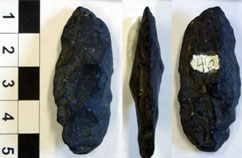Collections
Many archaeological investigations have taken place in Washington over the years, resulting in numerous collections of artifacts related to the history of this region. The collections resulting from surveys and excavations across the State consist of material important to a better understanding of our cultural and natural past.
 Many archaeological materials are not suitable for display, but provide researchers with valuable information: artifacts from the smallest flake tool to the heaviest millstone, soil samples, as well as botanical samples and archival documentation from the projects help us better define ourselves and region. A soil sample may not seem particularly interesting, but pollen grains and plant remains meticulously removed by researchers help recreate an accurate picture of long-ago settlements. Proper cataloging and long term care (aka curation) ensures that these one-of-a-kind materials are available for future people to study. If artifacts are fragile or perishable, museum staff clean and treat them to stop deterioration. Museum staff and conservators know how to clean and care for various materials from which artifacts are made: glass, ceramic metal, bone, cedar, stone, shell, and more. With proper care, archaeological material that has lasted for thousands of years will continue to provide information for thousands of years into the future.
Many archaeological materials are not suitable for display, but provide researchers with valuable information: artifacts from the smallest flake tool to the heaviest millstone, soil samples, as well as botanical samples and archival documentation from the projects help us better define ourselves and region. A soil sample may not seem particularly interesting, but pollen grains and plant remains meticulously removed by researchers help recreate an accurate picture of long-ago settlements. Proper cataloging and long term care (aka curation) ensures that these one-of-a-kind materials are available for future people to study. If artifacts are fragile or perishable, museum staff clean and treat them to stop deterioration. Museum staff and conservators know how to clean and care for various materials from which artifacts are made: glass, ceramic metal, bone, cedar, stone, shell, and more. With proper care, archaeological material that has lasted for thousands of years will continue to provide information for thousands of years into the future.
Artifacts that are made from organic materials need special care to stop them from rotting or decaying. Artifacts that come from underwater sites (such as a shipwreck) also need special care because they were accustomed to certain conditions like cold, wet, high pressure, low light and little oxygen. This type of care requires curatorial facilities with trained staff, controlled environmental conditions, pest control plans and the proper tools and equipment to stabilize the artifacts. Some artifacts, such as stone and glass, require less labor-intensive care, but require the same level of on-going professional management.
In order to standardize the quality of care nationwide, the Department of the Interior published 36 CFR Part 79 in 1990. These requirements define minimum capabilities for long-term curatorial services, including policies and procedures, facilities requirements, and staffing and experience.
 Currently, Washington State rules require that artifacts from public lands managed by the state of Washington or by political subdivisions of the state, such as cities, counties, ports, school districts and other special districts, that are excavated under a Washington State Excavation Permit, be curated in a repository that meets the federal standards published in 36 CFR Part 79 . Most agencies do not have the required staff expertise, or the facilities, to curate archaeological collections, so must choose to place collections in facilities that meet the federal standards. This saves agencies money and allows them to focus on their core responsibilities. In Washington State, collections can be deposited at repositories including university, tribal and local museums.
Currently, Washington State rules require that artifacts from public lands managed by the state of Washington or by political subdivisions of the state, such as cities, counties, ports, school districts and other special districts, that are excavated under a Washington State Excavation Permit, be curated in a repository that meets the federal standards published in 36 CFR Part 79 . Most agencies do not have the required staff expertise, or the facilities, to curate archaeological collections, so must choose to place collections in facilities that meet the federal standards. This saves agencies money and allows them to focus on their core responsibilities. In Washington State, collections can be deposited at repositories including university, tribal and local museums.
For more information on curation of archaeology collections, please visit: Association of WA Archaeology, whom has organized a consortium of private, state, tribal, and federal agency representatives that meets twice annually to discuss curation and museum issues as they relate to archaeological collections.




